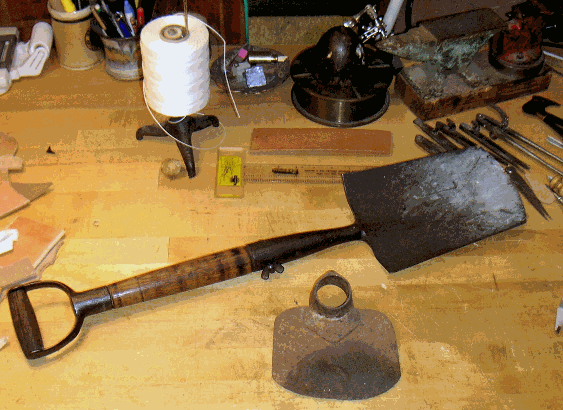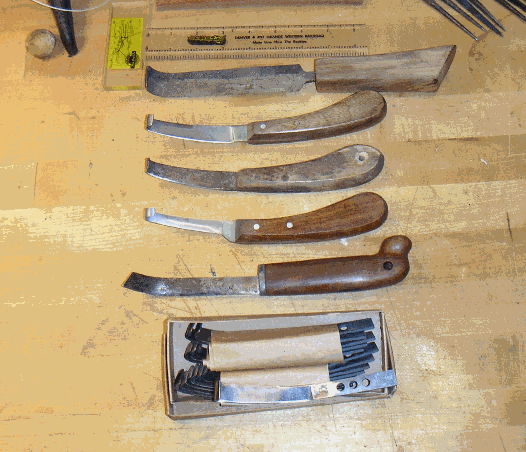Crook
Knives, Shovels & Hoes
By John
“SnakeOyl” Kramer, NAF #4M
Back in the early
seventies we could still buy Sheffield crook/canoe knife
blades identical to those traded for more than two centuries.
Since the eighties those have disappeared from world trade and
we’ve had to make do with other sources many of whom are not
aware of the many subtleties of crook knife manufacture.
Most think the name is a
result of the bent blade seen on many examples but there are
curved blade and straight blade knives both common in museum
collections. The better consideration is that the name is the
result of the handle which is made to ease using the tool as a
one-hand draw knife.
As children we were
taught to never cut toward ourselves yet a crook knife is
designed to do that very thing. The trick is to keep your
elbow tight against the trunk of your body to limit the travel
of the blade so if it slips in the cut – it can’t cut you.
On occasion the knife will be flipped over and used in reverse
when it better accommodates the work.
There are a few
characteristics common to all good crook knives. Crook knives
are sharpened on one edge only like a chisel or plane blade or
a knife designed to cut cordage (a few homemade knives
particularly those made from straight razors are the
exception) . Every knife is right or left-handed. Nearly all
were hafted by the first owner.
Some of the more refined
patterns mount the blade at a 20 degree angle from the axis of
the handle.
The blades may be a foot
long 2” wide and a quarter inch thick or 2” long, 3/8”
wide and 1/16” thick. They may be bent, curved or straight.
Each design has its
purpose as evidenced by the many names attributed to them over
the years. In various cultures they are known as “man’s
knife”, “canoe knife”, “bent knife”, “bowl and/or
spoon knife” and many more. The bent/curved blades can scorp
out a bowl or help carve a thwart. The straight blades can
split ribs and lashings, carve a paddle, do fine carvings or
flesh a hide.
Crook knives are one of
the most useful tools you can carry to aid comfortable
wilderness living. Choose wisely.
There are many forms of
crook knife which are known by other names. The one most
common to what we do is a hoof knife. The bend in the blade is
on a tighter radius than most crook knives but it can be used
for the same purposes study the curvature and choose the one
you need.
Many of the bent blade
knives used by wood carvers are just variations on the ancient
crook knife theme.
A few years ago we had a
long discussion on an Internet history list about shovels. I
had never thought much about shovels assuming they were as
common and useful then as now.
In digging through old
records it has become apparent that very few shovels made it
to the mountains only a very few are listed on inventories and
invoices and though digging caches is a fairly common thing
mentioned, seldom does the mention include a shovel. I also
made inquiry with the salvager's of the 1850 Steamboat Arabia
– another surprising lack of shovels, plenty of hoes.
Perhaps it was something
made at the Forts and Trading Posts by the local blacksmith,
as flat steel was easier to transport? No indications one way
or another. Seems unlikely as making a good shovel requires
real skill and a fair expenditure of labor.
One thing that did turn
up pretty often on trade lists were hoes. There is at least
one mention of digging a cache with knife and skillet; I'm
certain some were dug with nothing more than sharpened sticks.
Today my shovel is an
important part of my camp gear because it aids things of
greater significance now than then. It helps maintain tight
control over the fire, digs convenient cat-holes in the woods,
pounds stakes, and much more. These things were of less
importance in the Early Nineteenth Century. Shovels are heavy
and awkward to pack. On reflection a hoe (Dutch or American
pattern) would be of greater utility and much easier to stash
in a pack.
You can often use a hoe
in place of a skillet for cooking chores, it can be used to
flesh and break hides, it only takes moments to fashion a
suitable handle of any convenient wood (even pine and aspen)
or the leg bone of a buffalo; and it would be superior to a
shovel for quickly digging the kind of hole needed to make a
cache in the Rocky Mountains. It can also be used to manage a
fire and dig cat holes.
We need more hoes in
camp.

“Early cast shovel
& hoe”

- “From top to bottom;
canoe knife made from old file, cheap import hoof knife,
quality USA hoof knife, cheap import hoof knife, personal
crook knife made from old style Sheffield blade, 1 doz quality
USA hoof knife blades NOS.”